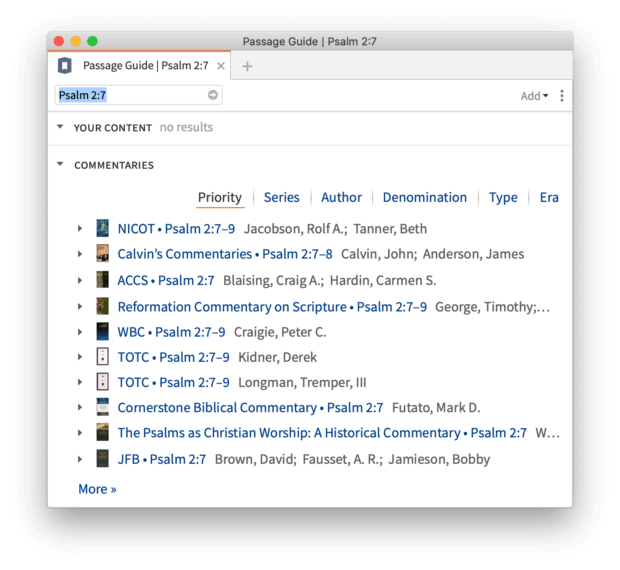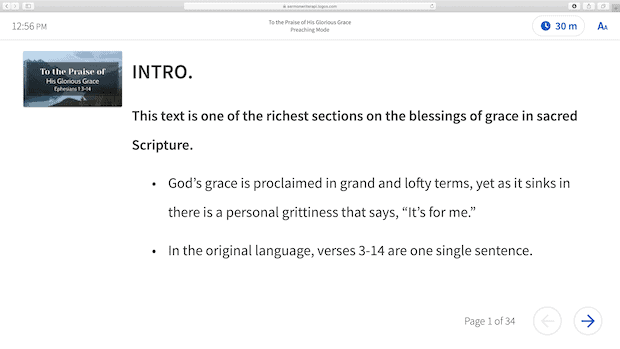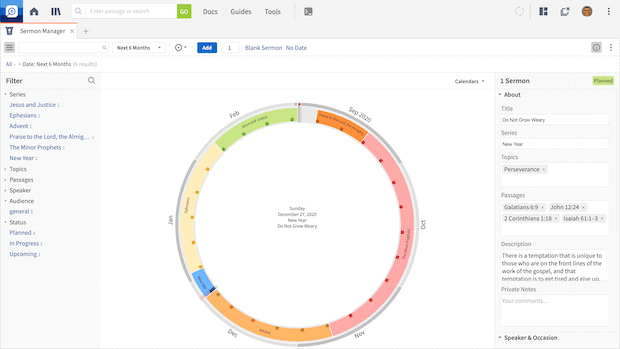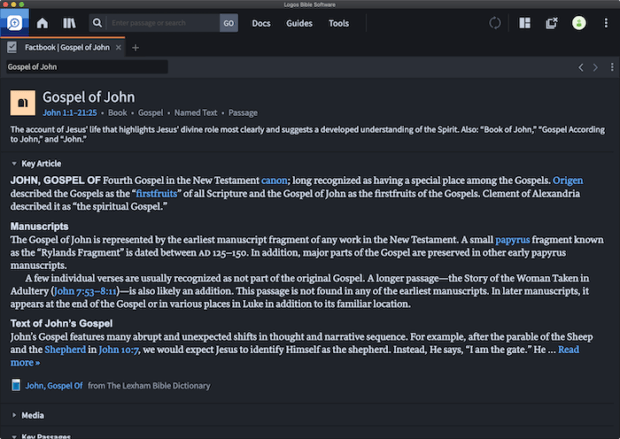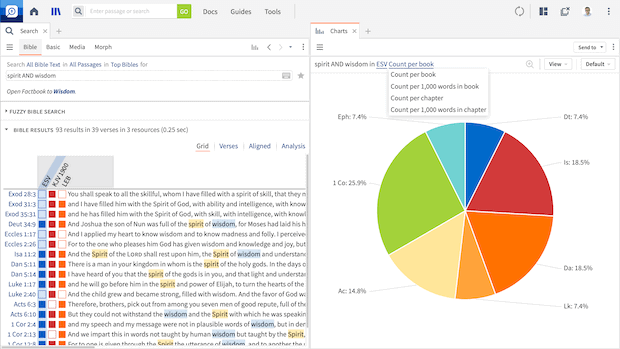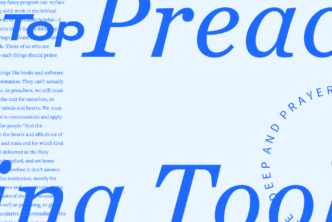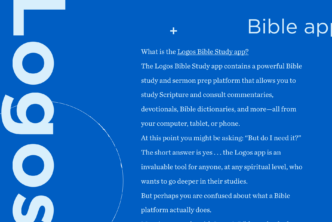Do you want to know how we talk about you, Logos Bible Software users, inside the hallowed halls of Faithlife? We call you “pastors and other Bible nerds.” You are the people we love and the people we know how to serve. Which is a little selfish because you’re the kind of people a lot of us are. We make tools we ourselves need and want.
Let me just tell you some of the things I’m glad this ever-improving software does for me. Oh yeah—and also for you. Pastors and other Bible nerds, rejoice.
Small but huge improvement
My favorite small-but-huge improvement with Logos 9 was actually something simple and brilliant that has already made one of my most common tasks easier: the Passage Guide now gives you far more information about the commentaries you have. Before, all I saw were titles, and those tended to be variations on A Commentary on Paul’s Epistle to X. It was hard to know which one I was clicking on. Now, however, I can see and sort volumes by series, author, denomination, type, and era. I have always loved the Passage Guide because one of the most important things Logos does for me is open up a bunch of commentaries for me to the right page so I can survey their viewpoints and arguments.
The new Factbook
This tool focuses on helping you study all kinds of things in the Bible, Church History, and theology. Ten times as many subjects are covered in Logos 9 than in previous versions, more dictionaries are tagged, more kinds of information are available: Hebrew and Greek words, specific sections of Scripture (like “The Sermon on the Mount”), biblical senses, timeline events, even geeky things like biblical manuscripts. Factbook also shows up in more places, for easy access (in the Go box, on the Everything search card, etc.); it connects to more tools; and for the first time, it has mobile and web app parity with the desktop software.
So if you look up “love,” you’ll get a full dictionary discussion of the concept from the Lexham Bible Dictionary; a list of key passages, an overview of biblical senses related to “love”; and links out to dictionary entries, journals, and sermons that further enlighten the topic.
You don’t just get a simple definition; instead, Factbook becomes your first stop for many of the things you search for in Logos. And it’s not a Topic Guide; it’s a high-level summary that helps you clarify what you’re searching for (word senses, for example) and gets you into your library more quickly. Let’s face it: Google does a pretty good job of finding some things in the Bible. But Google and Wikipedia also get things wrong, and they search books and articles of questionable value. Logos, by contrast, is a curated set of resources—curated by you—and Factbook searches them all for you.
See how it works:
Sermon Builder and Sermon Manager
I played a small part in the design of the original Sermon Editor, and it has seen continual improvement since then. It is now called the “Sermon Builder” to describe what it does more accurately. Not only does it provide me preacher-specific tools like speaker prompts and auto-generated visuals, but it also works with the whole Faithlife ecosystem. And, most important to me (and therefore to you, right?), Sermon Builder gives me a clear and lightweight way to move from preparation to preaching. I just click the “Preach” button, and Logos gives me a paginated (or scrolling, but I prefer pagination), large-text version of my sermon I can take into the pulpit. I get to see my slides, my styles, and a timer. And nothing else. That is so key.
And once I’m done preaching, Logos automatically files my sermon away for future use in the Sermon Manager. I am not the main preaching pastor at my church; when I prepare sermons, I tend to reuse them while guest preaching in other places. It is so helpful for me to keep an accurate accounting of where I’ve preached a given sermon. For example, I like to make sure that I don’t overuse illustrations, but when I preach in multiple places, it can be hard for me to remember what I’ve said where. A searchable database of my own sermons is a very useful thing.
And speaking of preaching and the future . . . the radial calendar assists preachers in planning sermons, even if they share preaching duties with other pastors. This isn’t just eye candy (though it is that!); it’s a useful way of visualizing where you’re headed in biblical exposition and a reminder of where to focus your preparation.
I find that when I know where I’m going, my outside reading—in Logos books, newspapers, blogs, and other sources—is more fruitful. My mind makes connections between upcoming passages and good illustrations I encounter.
Reading Plans
Just right-click on a book in your library, click “Start reading plan,” and Logos builds a reading plan that breaks the book at natural places rather than places picked by a computer counting characters.
On mobile, the end of your reading for the day is easier to see than it used to be. The only reading you see is the assigned block. Watch this quick video to see how Reading Plans work:
Counseling Guide
I’ve always said that Logos is an “information filter.” Here’s what I mean: even a smaller base package can contain so many books that you’ll forget you own some of them; so our various guides help organize your library for you, delivering to you just what you’re interested in studying at the moment.
Enter the Counseling Guide. Pastors, Bible study leaders, lay counselors, and others can look up all kinds of counseling topics—divorce, anger, abuse—and get a summary of the topic, links to related topics, a list of hand-selected biblical passages, and links to any books they might own on the topic. I know that for me, I especially want to have relevant biblical passages at the top of my mind. I want to give people better wisdom than I could come up with myself.
Notes
I’m going to be honest: I was deeply invested in another note-taking system before Logos 8 radically improved Logos Notes. I did finally import my notes into Logos, but I had been uncertain whether to jump fully into Logos’ notes system. One thing that held me back was that I couldn’t add images to those notes.
But with Logos 9, I can—and so can you. Screenshots of images useful for sermon illustration, charts, and graphs from elsewhere in Logos—any image we need to file away, we can. It’s this kind of iterative change, steady improvement, that wins my trust in Logos.
Dark mode
One Logos feature many people, including one of my best pastor friends, begged for is dark mode. You dark mode people know who you are. I’m not one of you, but neither am I a light mode person: I’m a “system setting” guy—I like my (Mac) screen to “warm up” (go a bit yellower) at night and “cool down” (go a bit bluer) during the day.
Charts
One strength of Logos has always been its ability to help exegetes visualize the results of Bible searches. Sometimes a chart brings to your attention a pattern you simply wouldn’t have seen otherwise.
For example, you can search for “Son of Man” and chart how often it occurs in each book of the Bible proportionally to the others. Choose “frequency per 1,000 words in book,” and you’ll see that Matthew uses Jesus’ famous self-designation more frequently than the other gospels. You’ll see that John uses it the least—and that Ezekiel beats all of them. It’s a tip-off for further study you might not have thought to do.
(You can also send the chart directly into Faithlife Proclaim with the “Send to” button.)
Lexham Survey of Theology
I was the editor for the Lexham Survey of Theology, which powered the Theology Guide in an older version of Logos. We promised back then to link more systematic theologies to it—and we did.
Check out “Union with Christ,” for example, and you’ll get hand-curated links to specific sections of potentially dozens of systematics—plus a link to even more resources in your library. It’s like a Passage Guide for your systematics: Logos has always been able to link you straight to comments on specific passages in commentaries, and I’ve often taken advantage of this power to survey many commentators. Logos 9 can link you to specific sections in systematics, enabling you and me both to survey multiple theologians in the same way. The alternative is checking multiple tables of content and indices; you and I just aren’t going to do that most of the time. This is truly a powerful tool.
Conclusion
Logos has always been about organizing and filtering information for good Bible study, presenting that information in a usable way.
I think it will do that for you too.
Take a quiz to see which Logos package fits your needs best!


